Birds
of America: Passenger Pigeon
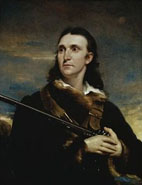
John
James Audubon,
wild pioneer
|
 Martha,
Martha,
the last passenger pigeon |
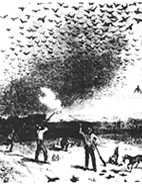
Passenger Pigeon shoot
- note dense flock
|
The
now fabled Passenger Pigeon is an emblem of mankind's troubled
relationship with the natural world. The bird's fate embodies
how, in a short span of time, our relative position with a species
can dramatically shift, at both an ecological and cultural level.
Extinct since 1913, with the death of the last bird, Martha, in
Cincinnati Zoo, the North American Passenger Pigeon was at one
time the most abundant bird on the planet, with single flocks
estimated to number over a billion birds. Prolifically and brazenly
hunted for food, feathers and hog-feed, Passenger Pigeon numbers
declined sharply in the late 19th century, when their sudden paucity
became a cause for public speculation and concern.
The
Manchester Museum has a Passenger Pigeon currently on display,
with a further two skin specimens and a dozen eggs in storage.
We looked at mankind's role in the pigeon’s complete obliteration,
and its evocative description and depiction by the artist and
naturalist John
James Audubon (1785 -1851). Audubon is renowned for his magnum
opus, The
Birds of America, in which he illustrated every North
American bird, life-size, in a double-elephant folio. The
University of Manchester library holds a rare complete set of
Audubon's original book, purchased in 1891, and letters which
relate to Audubon's frustrating visit to a dank and gloomy Manchester
in 1827, in search of wealthy subscribers.
In November 2007 we travelled through Kentucky, the home state
of Audubon, to seek out locations recalled in his journals; in
particular that of the phantasmogorical account of the flight,
and subsequent slaughter, of the flocks of Passenger Pigeons in
the woods by the Ohio River. We also visited Reelfoot, Tennessee,
an area of cypress swampland created by the 1811 New Madrid earthquake,
which Audubon described while riding through the barrens of Kentucky.
We worked with musicians to arrange a rare performance of 'Coro',
a little known piece by the maverick Bohemian composer, fellow
immigrant, woodsman and acquaintance of Audubon's, Anthony
Philip Heinrich. 'Coro' is adapted from Heinrich's epic oratorio, Legiones columbarum americanarum sylvestrium, and describes
the overwhelming effect of the arrival and departure of a vast
flock of passenger pigeons, to the amazement of a huntsman and
a passing traveller.
Our research also led us to the La Forêt de la Double, Périgord,
to document French huntsmen shooting migrating wood pigeons. With
nets, pullies and stool pigeons "les chasseurs" use
similar methods to the 19th century pigeon hunters in the backwoods
of Kentucky.
|
Jacob
Cartwright & Nick Jordan
Where Is That Vanished Bird?, photomontage, 2007 |
Our
interest in John James Audubon's description of vast flocks of
Passenger Pigeons, and other texts accompanying Birds of America, formed the basis of two new films West Point and New Madrid. The first two parts of a trilogy of video works,
the films explore the territory between cultural & ecological
history, the past & present, and the human activities that
alter and shape the diminished natural world:
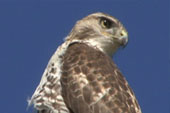
|
West
Point
the hunting of the Passenger Pigeon
23:50 mins. Cartwright & Jordan, 2008 |
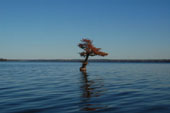
|
New
Madrid
the earthquake of 1812
06:40
mins. Cartwright & Jordan, 2008 |

|
Click
here for a slideshow of our trip, from Louisville, Kentucky, down to the confluence
of the Ohio & Mississippi rivers. |
|
Trees of Britain:
Oak
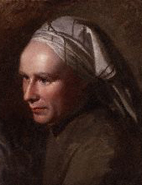
William
Cowper,
pastoral poet
|
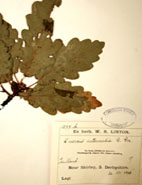 Oak herbarium
sheet,
Oak herbarium
sheet,
The Manchester Museum |
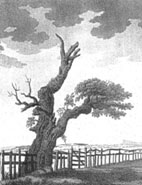
The Parliament Oak
by Major Henry Rooke, 1790
|
Since publication of our collaborative book Alien Invaders:
a guide to non-native species of the Britisher Isles, we
have been researching an archetypal, native species, with historic
roots in the our cultural, natural and spiritual landscape: the
British Oak. Through the University's library, our research has
been inspired by Jacob George Strutt's (1790-1864) 'Sylva Britannica', Hayman
Rooke's (1722-1806) 'Descriptions & Sketches of Some Remarkable
Oaks' and William
Cowper's (1731-1800) epic unfinished poem Yardley
Oak. Battling with bouts of delirium and melancholy,
Cowper was a forerunner of Romanticism in England. Yardley
Oak is a descriptive and meditative fusion of the personal
with the public. Disturbed by increasing land enclosure and commercialization,
the twisted and ancient oak is presented by Cowper as a totemic
monument to a shared English identity, through which the inevitability
of time's dissolution and decay is brought home to roost.
Our
interest in and use of the oak tree is formed around notions of
ideology, Nationhood, history, myth, symbolism - the ways in which
we project human characteristics upon flora and fauna - how nature
is put to work to represent human interest. In this context, the
oak is fundamentally intertwined with British history and notions
of nationhood, together with landownership, bucolic and pastoral
ideals - cultural tropes that still resonate in the national consciousness
and which, alongside the incredible beauty and material complexity
of the oak tree, have provided us with plenty of material to work
with.
The
Oven Bird
There is a singer everyone has heard,
Loud, a mid-summer and a mid-wood bird,
Who makes the solid tree trunks sound again.
He says that leaves are old and that for flowers
Mid-summer is to spring as one to ten.
He says the early petal-fall is past
When pear and cherry bloom went down in showers
On sunny days a moment overcast;
And comes that other fall we name the fall.
He says the highway dust is over all.
The bird would cease and be as other birds
But that he knows in singing not to sing.
The question that he frames in all but words
Is what to make of a diminished thing.
Robert Frost (1874–1963)
Mountain Interval, 1920
|